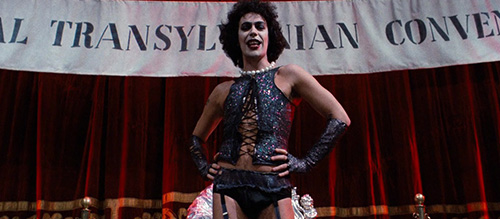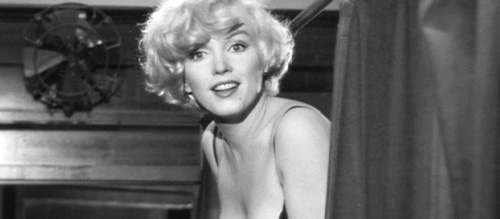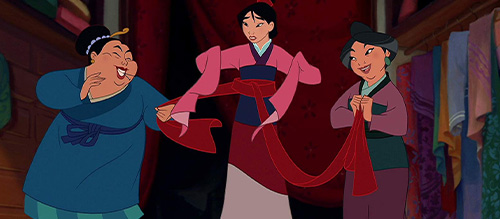5 of the Best Character Introductions in Movie History
3. Dr. Frank-N-Furter
The Rocky Horror Picture Show (1975)
Everyone familiar with Mary Shelley’s “Frankenstein; or, the Modern Prometheus” (1831) can’t deny that Victor Frankenstein is an eccentric doctor with a God complex. So, we’re left with the illusory opinion that beating this type of eccentricity will be difficult. Upon meeting Dr. Frank-N-Furter (Tim Curry) from Jim Sharman’s The Rocky Horror Picture Show (1975) however, we realize our assumption is wrong.
Another mad scientist with crazy hair, but with several changes and a memorable entrance, Dr. Frank-N-Furter sings his way into our minds and, in most cases, our hearts.
First of all, the character has to be gazed upon through a 1970s lens. With that in mind, it’s safe to assume that most members of the audience are represented on screen by Janet Weiss (Susan Sarandon) and Brad Majors (Barry Bostwick) and are therefore shocked by Dr. Frank-N-Furter’s appearance and song performance of “Sweet Transvestite”. The character’s perfect summation is twofold: the lines sang by Tim Curry, “don’t get strung out by the way I look,/ don’t judge a book by its cover./ I’m not much of a man by the light of day,/ but by night I’m one hell of a lover” couldn’t be more accurate, unless they were followed by Dr. Frank-N-Furter flinging open his cape to reveal his lingerie.
The introduction works so well not only due to Curry’s excellent portrayal, but also because it builds up suspense and lands in a well deserved moment of shock value that brings to the fore the character’s core values: his desires and his need to challenge. The only reaction left for the audience at this point is confusion; Dr. Frank-N-Furter blurs the boundaries of the male/female binary (for audiences at the time). Despite being confused, however, every person in that dark room has met Dr. Frank-N-Furter within minutes of his entrance.
Recommended for you: [Video] 30 Greatest Musical Numbers from Movie Musicals
4. Sugar Kane Kowalczyk
Some Like It Hot (1959)
While Dr. Frank-N-Furter is paradigmatic of how using one’s sexuality can be empowering, the same can’t be argued with the depiction of women in film during the 1950s and 1960s. One such an example is Marilyn Monroe’s Sugar Kane Kowalczyk from Billy Wilder’s Some Like It Hot (1959). This is made particularly obvious when we compare her entrance with Tony Curtis and Jack Lemmon’s as Josephine and Daphne respectively. Although in female attire, the two men are framed by the camera in a way that allows the viewer to see them as whole people. Further, the speed of their pace, accompanied by a soundtrack with a fast and humorous rhythm, guides the audience to laugh at their clumsiness.
Moments later, however, when Sugar enters the scene, we get a completely opposite experience. The whole atmosphere changes from ridiculous to sensuous due to a differently paced beat. From the very get-go, therefore, we understand that Sugar is a sort of naïve character that we’re merely meant to gaze upon. This also becomes evident as the previously objective point of view of the camera becomes an intrusive close-up of her thighs; the frame is indicative of Sugar’s most prominent quality, according to the film, until the very moment that steam is blown on her from the train; the comment is obvious: she’s hot.
Sugar’s label as the hot woman-object is established not only visually, but also verbally. After Sugar’s character introduction, Jo and Jerry frame it with a male dominated point of view: “look at that! Look how she moves. It’s like jell-o on springs. It’s as if there’s a built-in motor or something.” Even from the very first sentence we are led to experience Sugar as an object rather than a person. Hence, despite the fact that she’s not a complete character herself, she is emblematic of the female character as a category of that cinematic era.
5. Fa Mulan
Mulan (1998)
Of course, the Some Like it Hot “50s in a bottle” type of female depiction still exists to this day, but there are several exceptions. One such an exception is Fa Mulan (Ming-Na Wen) from Tony Bancroft and Barry Cook’s Disney animated film Mulan (1998).
As the opening credits come to an end, we meet Mulan as she tries to prepare for her meeting with the Matchmaker (Miriam Margolyes). Mulan is late for her make-over and it’s clear that she’s significantly unprepared, which is indicated, for instance, from the notes on her arm. Mulan, therefore, is not the typical girl from a Chinese village; she’s clumsy, she’s giddy and generally she’s not really interested in learning how to follow societal preconceptions of the female gender. Despite all that, Mulan is not disrespectful or indifferent towards her family; she wants to do her duty and bring honor to them as the film’s first song keeps reminding us of; she’s just unable to do so in their ways.
Notably, the song itself is a vital component of Mulan’s introduction because it demonstrates not only how high the stakes are, but also how Mulan can’t abide by these limited rules. The song builds an image of the perfect woman according to stereotypical views of femininity of this specific cultural background: “A girl can bring her family great honor in one way/ by striking a good match/ and this could be the day”. In order to succeed, the song continues, girls have to be “calm, obedient [and] work fast-paced”. Lastly, the song deals the final blow: “we all must serve our Emperor who guards us from the Huns./ A man by bearing arms./ A girl by bearing sons”. If these lyrics are unpacked, the message is clear: Mulan can bring honor to her family by serving the Emperor only through a successful marriage, but she can only do so if she performs the role of the good girl who has the potential to become a proper wife.
Even if this song marks the film’s opening, we acknowledge that Mulan is different from the other girls her age, and she knows it too. Regardless, at this point Mulan has internalized these preconceived views on how a woman should be, and she tries to do right by her family. For example, she wants to bring them great esteem as it is evident in her part of the song: “Ancestors hear my plea/ help me not to make a fool of me/ and to not uproot my family tree./ Keep my father standing tall”. Mulan represents her family at this particular moment, and if she fails, she’s not the only one that will have to face the repercussions; her whole family, and particularly her father, will have failed. Although we’re barely ten minutes into the film, the song and Mulan’s attitude throughout its duration offer an insightful and empathy-driven introduction to the newest of Disney’s princesses.
Recommended for you: the other entries into our 5 Best Character Introductions series
Written by Ioanna Micha
You can show your support for Ioanna at the following link:
Twitter – @MichaIoanna
For more lists like this one and updates direct to your timeline, make sure to follow The Film Magazine on Facebook and Twitter.
[DISPLAY_ULTIMATE_SOCIAL_ICONS]




